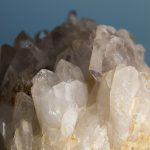Hiddenite is a green color variety of spodumene. Normally, it may be confused with emerald green.
Hiddenite was first found in 1879, and in strict terms is defined as the green, chromium-rich transparent variety of Spodumene from North Carolina. Although additional localities containing transparent green Spodumene were found since then, their significance lacks in comparison to the material from the type locality. Chromium impurities are responsible for the green color in North Carolina Hiddenite; the other localities generally produce lighter colored and more yellowish in tone, and lack the chromium.
In a strict sense, the term Hiddenite refers specifically to the green transparent Spodumene variety originating in Alexander Co., North Carolina. However, since the recent discoveries of green Spodumene in Afghanistan and Brazil, the term has been corrupted by the gem and mineral industry to include all green gem Spodumene from other localities. Natural Hiddenite from North Carolina is very rare and increasingly difficult to obtain.
The perfect cleavage and splintery fracture of Hiddenite make it a difficult gemstone to facet. It is very sensitive to knocks and will chip if hit too hard. Hiddenite is also strongly pleochroic, showing lighter and more intense coloring when viewed at different angles. Hiddenite can also be multicolored with more yellowish tones on one end and greener on another; or even one side deep green and the other nearly colorless. In general, deeper green and uniform color in Hiddenite increases the value.
Hiddenite, like Kunzite can fade upon prolonged exposure to bright light and sunlight. It may also be artificially produced by irradiating other forms of Spodumene, and these are very difficult to distinguish from the natural forms. Thus one should always be cautious and only purchase this gem from very reliable dealers.




























Leave a Reply
You must be logged in to post a comment.